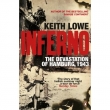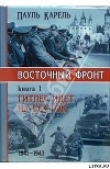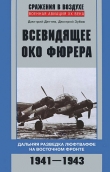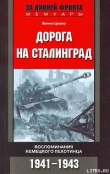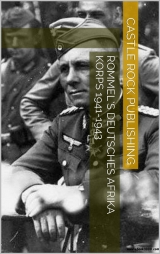
Текст книги "Rommel's Deutsches Afrika Korps 1941-1943"
Автор книги: Автор Неизвестен
Жанры:
История
,сообщить о нарушении
Текущая страница: 8 (всего у книги 19 страниц)
To the west of Sidi Rezegh there was-the Bottcher Group and the Italian Divisions, to the north the 90th Light Division, while from the east there was the growing pressure of the two panzer and one Italian armoured divisions. But not until he contacted his headquarters did Rommel know that far from being beaten as he thought the British might still gain the upper hand through their better supply position for they were still able to renew their strength with fresh men and tanks while theAxis forces had reached the end of their tether.
During the period from 24 to 27 November the fortunes of the Panzer Group Africa can be seen to have changed alarmingly and by 27th the situation around Tobruk had become critical. The ring round the town had been split, the Axis forces driven back and at the end of their strength. The 30 Corps had been massively reinforced and was again posing a serious problem south-east of the town. The supply system, already bad, had become critical and there were grave doubts expressed whether Corps had the strength to restore the situation.
The rainy morning of 28 November saw 21st Panzer Division encountering heavy resistance around Zaafran but not only had part of it held the eastern pressure out of Tobruk but other elements made contact with 90th Light and. on the southern flank another column of the division passed Bir el Chleta and headed for Sidi Rezegh to which sector 15th Panzer Division was also heading. That formation put its main on the important high ground south of Belhamed and drove off the counter-attacks to the south which 8th Army had launched. During the day and despite the poor light a collaboration between 15th Panzer and Ariete Divisions encircled a number of British tank groups. The German commanders now were obtaining a clearer picture of the situation and their speedy regrouping allowed them to begin operations aimed at defeating the New Zealand and British forces.
One thing was very clear to the German command; although British material losses could be speedily replaced the restoration of confidence in the tanks and in the leadership would take much longer to build up. This point was borne out in Kippenberger's book Infantry Brigadier where he claimed that throughout the 8th Army there was a most intense distrust, almost a hatred of our, that is to say the British, armour. Suspecting this feeling Rommel reasoned that 8th Army must be beaten before it had fully recovered for he knew that already British forces were regrouping and reforming without let or hindrance along the Trigh el Abd, an area now empty of Axis troops.
The question which Rommel had to decide that day was whether to drive die British and Imperial forces, positioned around Sidi Rezegh, back into Tobruk or to cut them off from the town and to destroy them in the field. He decided on the latter course. The 21st Panzer Division held position and was involved in fierce fighting on both sides of the Trigh Capuzzo while 15th Panzer drove past the New Zealand flank to thrust back South African counter-attacks eventually to link up with the Bottcher Group and XXI Italian Corps. A short rest and then 15th Panzer swung northwards gaining in strength as it picked up other Axis fighting units from the area through which it passed before it went on to attack and to capture El Duda from the Tobruk garrison. So fast had been the pace of the advance that the infantry had become separated from the panzer spearhead and armoured personnel carriers had to halt their advance to go back and to porter the troops. The !osses suffered that day were more than usually heavy and regimental strength of one infantry regiment had been reduced to 150 men by the time that El Duda had been taken. At that place, determined in spirit but weak in number the Germans took up all round defence but strong British infantry assaults drove back the German infantry from their positions and in the fighting more than half of them were taken prisoners of war.
Ariete and 15th Panzer Division then came under a series of heavy but unco-ordinated attacks launched by 7th Armoured Division and 1st South African Division on the southern flank trying to break through to the New Zealand Division but on 21st Panzer Division's sector the aggressive defence put up by the New Zealanders forced the Germans to commit its last few reserves. During the afternoon an attack by 4th Armoured Brigade hit the Bottcher Group but was deflected while the 15th Panzer Division swung through the intervals in the Axis line and struck north towards El Duda. The Africa Corps battle report recorded the destruction of 20 British tanks from a group of 100 which had begun an attack and these severe losses forced 8th Army's leaders to order a withdrawal south.
On the far northern flank of the battle 90th Light made strenuous efforts to close the narrow corridor but despite its struggle and the intervention of an anti-tank company no firm link had been made with 15th Panzer by that evening. Panzer Group had now concentrated and surrounded the main of the New Zealand and elements of 7th Armoured Division. The corridor was narrowing in width, British attacks on the southern front were weakening and were being beaten off, only on the far eastern Sollum front had there been defeats. The garrisons at Bardia, Sollum, and Halfaya were once again surrounded and cut off. The decisive attack against the New Zealand Division went in on 30 November but it was not co-ordinated because 15th Panzer Division arrived late at its start line, for as a result of false orders it had beer, given its units had had to spend the night in a fruitless desert march. To hide the direction of the main Axis thrust feint assaults were made against a number of points, particularly at Sidi Rezegh. Although the German assaults began well the Royal Air Force attacks soon halted the forward movement for the British High-Command, realising the desperate situation, had brought every arm to bear to aid the encircled troops who were defending themselves with the utmost tenacity. Particularly did the strength of the British artillery distinguish itself during the fighting and the panzer forces gained a healthy respect for its accuracy and its punch.
In the early afternoon 15th Panzer Division, having rested after its night drive, came roaring up, made its first strike to the north, swung wide of Sidi Rezegh and then turned east to encircle the main British force from the west This now had the 90th Light to the north, 21st Panzer to the east, Battle Group Mickl, a new formation chiefly artillery in composition, and Ariete to the south-east.
When the German units were in position Mickl Group, supported by a machine gun battalion and 8th Panzer Regiment, began to exert pressure upon the New Zealanders. Then the British corridor into Tobruk came under fire. Fresh, unsupported, and unsuccessful British attacks to rescue the trapped colonial troops were made from the south but these were thrown back by the combined strengths of Mickl Group, Ariete Division, and the left wing of 21st Panzer Division. British armour then probed for a weak spot in the German ring and Axis reconnaissance units reported that enemy forces were in movement from Bir el Gobi in the west. The 21st Panzer came under pressure from British forces outside the encirclement. During the night of 30 November/1 December, the South Africans made an unsuccessful assault to break the German noose and the New Zealanders were then ordered to break out south-eastwards.
In the foggy light of 1 December the 15th Panzer made its killing thrust from the north of Sidi Rezegh. The battle group was made up of 8th Panzer Regiment with elements from 90th Light, 200th Regiment, a machine gun battalion, 15th Motor Cycle Battalion, and two battalions from 33rd Artillery Regiment as well as a 21cm howitzer battery. Heavy resistance by 8th Army at first delayed the advance but by 10.40hrs the encircled Imperial troops had been captured while outside the ring 4th Tank Brigade and other British units mounted a series of fierce assaults on Mickl Group and 21st Panzer Division to ease the pressure upon the trapped New Zealanders.
By late afternoon of 1 December it was nearly all over. The 15th Panzer and 90th Light Divisions had overcome the British defences and by linking hands had cut Tobruk off again, although the garrison of the town had lengthened the perimeter by a further 8 miles and held the strategic height which dominated the Axis supply route.
As the December daylight faded the remaining New Zealand units were destroyed one by one and by 2 December, after five bitter days of battle the fighting died away. Two thousand prisoners had been taken, together with more than 40 guns and a mass of equipment. The last two days had truly been a battle of attrition and at the close of the fighting foe and friend alike sank exhausted to the ground. Operation Crusader had ended.
Although 2 December marked the end of the Crusader offensive the campaign continued and the immediate post-battle interlude was used by both sides to regroup their forces. Each side had at least one division which was still ready for action. For the British this was 4th Indian which in the days after Crusader sealed off once again and even more strongly the Axis garrisons in Bardia, Sollum, and Halfaya.
On the German side 15th Panzer was still fit for action but the strength return of that formation gives an indication of how hard had been the battle. On the evening of 1 December only 11 Panzer II, 24 Panzer III, and 3 Panzer IV remained. The Africa Corps report for 3 December stated that more than 167 of its tanks and armoured cars were a total loss. The Italians had lost more than 90 of their armoured fighting vehicles but the British had suffered the destruction of over 800 machines. In personnel the German casualties were 600 killed, 1900 wounded, and 2200 missing. The Italians suffered less as the bulk of their forces were not so deeply involved. The British and Imperial forces had lost heavily and more than 9000 of 8th Army had been taken prisoner.
Most battles have a tactical and a strategic outcome. Strategically the British won the day for they wece able continually to reinforce their Army and go on to push the Axis forces out of Cyrenaica. The Germans had gained a tactical success and had used mobility, the speed of attack, and the greater range of their tank guns to reduce the numerical superiority of their British opponents. When attacking they struck at the weakest part or element of the 8th Army line with the strongest possible force and, when forced on to the defensive had fought aggressively. Their intention had been to destroy the British force; mere possession of ground they saw was unimportant and could under certain conditions be a burden. They had, therefore, been prepared to give ground temporarily to conserve strength in order that, at the appropriate time, strength would be available for them to make a counterstroke and to regain the territory which had been lost.
Against the new British attack which opened on 8 December and which had come up from Bir el Gobi the Germans had no more strength and as the Italian motorised Corps could not be ready in time to take up its defensive position, panzer group ordered the withdrawal to begin. The Axis troops fell back upon the Gazala line but so closely did the British pursue them that they reached the Gazala positions at the same time as the Italians.
Cyrenaica was indefensible. Rommel recognised the truth of that thesis or, to qualify the thesis, it was indefensible with the forces which he had available. Wavell had been the first to prove and Rommel had gone on to show that the deserts which lay to the south of the great curve of the Gulf of Bomba presented no obstacle to the determined commander. Although he resolved not to give ground without a battle and was prepared to offer the most determined resistance whenever possible, Rommel's decision to withdraw from the province was completely misunderstood in Rome, Berlin, and, even by his superior, Bastico. This latter set his face absolutely against the evacuation of territory until Rommel offered him the alternative of either agreeing to give up ground or of trying to hold Cyrenaica without German troops, for Rommel was quite prepared to leave the Italians to fend for themselves if his plan was not followed. Kesselring, the Supreme Commander South, intervened and together with a number of German and Italian officers opposed Rommel's intention for they considered the loss of Cyrenaica would have political repercussions for Mussolini. Rommel dealt with their objections poim by point and convinced them that, in view of the continuing and omnipresent problems of insufficient men and supplies, there was no other choice.
A new British thrust on 16 December threatened the panzer force with encirclement but Rommel ordered that battle be avoided and that his troops break out. He knew the true weakness of his command and that if it were to stand and fight then its strength would be reduced to a point where Tripolitania could no longer be defended. Nothing but defeat could be gained from fighting.
The Axis forces flooded westward withdrawing past the fortress of Tobruk and giving ground in the face of 8th Army's pressure. By Christmas Benghasi had fallen, although at a high cost to the British in men and material, and still the rearward movement continued until the whole Axis army had moved back to take up the new battle line in the prepared positions which ran from Marada to Marsa el Brega. By 7 January this move had been carried out and. with a shorter line to defend, Rommel could now begin to build up strength again to mount an offensive which would capture Cyrenaica and drive forward to the Suez canal. Hundreds of miles to the east Halfaya still held out unsupported and without hope of reinforcement. It was to continue its resistance until 17 January but then when its water supply was cut the garrison surrendered.
Rommel's counter-offensive opened on 19 January and under cover of a sand storm the Panzer Army made a surprise thrust towards El Agheila. Two days later an infantry and a machine gun Battle Group Marcks, was led in person by the German commander-in-chief through the mine-fields east of Marsa el Brega while the main of Africa Corps moved south of the Via Balbia. Agedabia was captured and immediately the Stuka squadrons occupied the field and from this front line position came into action against British tank forces. If the offensive had shocked the British it had come as a complete surprise to Rommel's superiors in the OKW and in the Commando Supremo, for Rommel had allowed no word of his intentions to be known.
The advance continued on 24 January when 15th Panzer with the 21st Panzer Division on its left flank swung south from Antelat opening a broad front as the advance was made towards Maaten Giofer. The Battle Group Marcks and an Italian unit continued to drive eastward to close a ring around the British and by midday of 24th these had been cleared from the area south-east of Agedabia and had lost 117 of their tanks in the severe fighting. Some British units escaped through a corridor between the Marcks Group and 21st Panzer Division but the main was surrounded and destroyed. On the morning of 25 January the panzer group moved forward again and attacked Msus, the main British supply depot, from which the Axis troops obtained no less than 600 trucks, 127 guns, and 280 armoured fighting vehicles.
The next move was to regroup and to form four battle groups which were to move upon Mechili and on 25th, while the bulk of the Africa Corps rested in the Msus-Antelat area, reconnaissance detachments and motorised infantry carried the advance eastwards. The Marcks Group, which Rommel led in person and in pouring rain throughout the long cold night, brought the assault forward until in the grey dawn of 27 January he had reached El Regima. By the afternoon that place had fallen and with it the airport of Benghasi. An infantry battle group cut round behind the town to block the Via Balbia and to deal within the city the British troops still fighting there. Once again the booty captured served the Axis forces well for more than 1300 trucks were captured together with food, equipment, and petrol.
There was no time for rest and once Ariete had taken over security duties east of Benghasi and Trieste Division had begun to carry out the same tasks in the Gemines sector the German reconnaissance in force continued at a mad pace. The coastal towns along the Via Balbia were taken one after the other defeating or throwing back the mainly Indian garrisons until at last Derna was reached.
Then began the final stages of the German advance to the Gazala positions ind at first these were to be occupied by the reconnaissance detachments only while the bulk of the Africa Corps stayed in Benghasi. The Italian XXI Corps was ordered to move up to secure the area between Benghasi and Agedabia. The first new mine-fields were begun on 3 February, the start of belts of such defences which reached deep into the desert from the coast for a distance of over 150 miles.
In the relative peace which the efforts of the strenuous campaigning of the past months then forced upon both sides, the Germans and their Italian comrades strengthened and improved their positions. The Gialo Oasis was occupied and thereby the southern flank of the Axis line was secured. Behind the main Gazala mine-fields others less extensive in area but dominating important sectors were also laid and anti-tank gun positions sited. The nex: months were taken up with resting, training, and preparing the troops for the forthcoming offensives of the summer.
Strike at Gazala
Cyrenaica was now safe but the undefeated 8th Army lay just across the desert and the conviction that British resources were seemingly inexhaustible, revived Rommel's fear that thousands of British tanks would one day come storming out of the desert. He decided to strike a pre-emptive blow which would capture Tobruk and then go forward to the Nile delta. But the genesi; of the German summer offensive had been an OKW order issued on 30 June 1941, which laid out a grand strategy in which a southern pincer would drive through Egypt to link up with two northern arms, one of which woulc advance from Bulgaria through Turkey and the other from the Caucasus through Iran. The success of this giant pincer movement was predicated upon the capture of Tobruk for Hitler refused to seize the Tunisian ports through which the army could have been more easily reinforced and supplied.
Cavallero, of Commando Supremo, planned to establish a giant depot at Agedabia from which the Axis troops could be nourished during their advance, but as an undefeated Malta remained a base from which Axis convoys could be attacked then Malta would have to be taken out. Discussions at the highest level authorised Rommel to mount an attack upon Tobruk but added that he was to halt at the Egyptian frontier to allow the maximum support to be given to the Malta undertaking. The timetable for the operation was the end of May to mid-June and Rommel was directed that if Tobruk did not fall then a withdrawal back to Gazala must be made.
The strain of battle had reduced the unit strengths but not the confidence of the Africa Corps but then convoys arrived bringing across reinforcements and equipment to fill out the shrunken units and to rearm them.
In addition to individual tanks whole companies of fresh men and machines came in and 5th Panzer Regiment of 21st Panzer Division which in February had had less than 70 panzers, had, by the end of April, been reinforced to a strength of 165, an establishment which the regiment had never had before nor would ever reach again. There was still a shortage of soft-skinned vehicles so that some units had only 60 of their official strength of 400 trucks. There were 12,000 men fewer than establishment for the whole of the Africa Corps, whose total strength, including supply troops for rear elements, was only 36,000 all ranks, the most acute shortage being in infantry.
Rommel then began to prepare the men of his command for the battle ahead. During May individual training gave place to company schemes and to collaboration with armour both by day and night. Special emphasis was laid on attacking prepared positions and permanent fortifications. Storm troop units were formed and these worked with combat engineers and tanks so that all-arm co-operation would be at a high peak of efficiency when the attack went in. By the end of May there were large-scale, divisional manoeuvres.
The 21st Panzer Division had been carrying out extensive patrol activity against severe British opposition and then the whole Africa Corps advanced into 'no man's land' at the south-eastern corner of Cyrenaica. This move fulfilled the purposes of thickening the battle line, of providing the maximum strength should 8th Army attack, and, lastly, of forming a firm jumping-off point for the panzers in the forthcoming battle. Officers were taken on secret reconnaissances to familiarise them with the terrain over which they would be fighting, forward fuel depots were, built up, and slowly, so as not to arouse suspicion, the number of shells fired was reduced to allow stocks to be gathered. On 12 May Rommel briefed the divisional commanders and then began the last minute preparations; traffic control points were established and the second echelon details sent back. To equip the fighting troops, orders were issued that all weapons, including those in training establishments and detachments, were to be handed in. The Africa Corps had girded itself for battle.
The 8th Army's defensive positions at Gazala stretched from the sea to Bir Hachim, a distance of some 45 miles and along the length of this very strong line defensive positions, known as boxes, had been laid out. These were usually sited on high or broken ground and capable of all round defence. They were intended mutually to be supporting and each of them had a strong garrison usually of brigade or equivalent establishment. To the west, that is the enemy side, lay extensive mine-fields of considerable depth and, in some areas, this sea of mines had been laid down on the eastern or 'friendly' side of the boxes.
To hold the forward, static defences Ritchie, 8th Army commander, put in 13 Corps. In the north, at Gazala, was 1st South African Division, then to the south 50th Infantry Division and 3000 men of 1st Free French Brigade holding the left flank box at Bir Hachim. This left wing was extended and strengthened by putting into a hastily prepared box, south-east of Bir Hachim. the newly arrived 3rd Indian Motor Brigade. At certain strategically important points along the southern flank and extending eastwards there were other boxes of which Knightsbridge, held by 22nd Guards Brigade, and El Adem were the most important. Behind the infantry boxes to give immediate support were 1st and 32nd Army Tank Brigades and behind this, located west and south of Tobruk, was the armoured mass of 8th Army, formed into 30 Corps. The 1st Armoured Division lay aside the Trigh Capuzzo and controlled the central sector while 7th Armoured Division was positioned farther south to deal with any threat from the direction of Bir Hachim.
The strengths of the two armies gave the British superiority. In armour there were 742 British tanks to 360 German and 210 Italian. In artillery there was a three to two superiority – 500 to 350 – a seven to five superiority in aircraft – 700 to 500 – and a larger number of men – 125,000 to 113,000.
The German commander-in-chief was faced with the choices of a frontal assault which would not only have robbed him of the element of surprise but would have allowed the mass of British armour to concentrate against him. The second alternative was to drive round the open flank at Bir Hachim and by a pincer operation from east and west of the Gazala position destroy 8th Army in the field. Rommel chose the second plan which had the advantages that the element of surprise would be maintained and that a successful assauh would divide the British Army in two and separate the infantry from its armour. The divisions holding the boxes in the Gazala position would not be able to release men to aid their comrades farther back because their whole attention would be needed to defend the western mine-fields. Neither could the Tobruk garrison spare forces and reduce its strength for then the town migh: fall to a coup de main.
Rommel's battle plan was for a diversionary attack to be mounted upon the northern, Gazala sector by X and XXI Italian Corps together with the non-motorised brigade of 90th Light Division. This force, known as CrüweL Group, would attack during the afternoon of 26 May and its aggressive moves were to hide the main thrust and to convince the British that the mass of German troops were on the northern sector. Instead, these would be concentrated in a second, mobile group. This would comprise the Africa Corps and the Italian XX (Motorised) Corps which, led by Rommel, would sweep round and behind the southern flank of 8th Army. Part of this group would strike northwards via Acroma and attain the coast thereby cutting off from the main of 8th Army the divisions in the Gazala sector. A pincer movement going in with the Crüwell Group from the west would then destroy the British and South African divisions.

Another part of the outflanking group would strike the British positions along the Gazala line in the back and to protect the flanks of this and the northern advance the motorised elements of 90th Light Division together with the reconnaissance battalions would drive eastwards towards El Adem and threaten Tobruk. [13]
The final preparations had been made. The routes forward had been marked with lamps, stores depots had been filled, a seven-day ration of food and water issued to all ranks, and, to aid in the deception plan, decoy convoys were sent out in the direction of Crüwell Group. The most difficult move in the opening stages of the operation would be the night drive by the outflanking force. This would be made over a vast distance and through unreconnoitred country by two Corps, neither of whom had even carried out such a manoeuvre at divisional level. Special measures were taken to ensure that distance and direction were maintained. The convoys were to move at exactly regulated speeds, 8 miles per hour in bright moonlight, on compass bearings which had been precisely worked out and the Luftwaffe was to drop flares throughout the night over the French held positions at Bir Hachim.
During the afternoon, with their movements hidden by the veil of a sandstorm, the divisions of the outflanking force moved to a point some 13 miles south-east of Rotondo Segnali there to rest and to refuel. At 17.00hrs on 26 May, the code 'Venice' was flashed; the battle for the Gazala line was on.
The attacks by Crüwell Group produced no reaction from the British. The Italian assault had been so weak and had been so well concealed by the khamsin that the 50th Division's boxes had not been aware that the attacks had taken place. At last light the fighting died down on the northern flank and Axis attention was directed southwards to where the outflanking group was marching through a brightly moqnlit light towards Bir Hachim. A short distance ahead of the main body were the advanced guards of 15th Panzer Division followed by the 'boxes' of the panzer regiment, the artillery and divisional headquarters, the motorised infantry, engineers, anti-tank, and other services. Between the two panzer blocks of 15th and 21st Divisions marched Corps headquarters. When it is considered that a panzer division's vehicles on the move covered an area of 11 square miles then it is possible to gain an idea of the impressive might of the Africa Corps and the Italian Corps as the divisions moved towards the British flank.
British armoured car patrols met en route, withdrew in the face of this armada signalling to 8th Army headquarters news of the desert march. At 04:00hrs on the morning of 27 May the great armoured mass, having marched 32 miles by compass bearing all through the night, halted south of Bir Hachim and there rested and refuelled before shaking out into attack formation. The strike force of the Axis army was now in position ready to carry out the next part of Rommel's plan; the northern strike. But 8th Army which had received the patrol reports had dismissed the movement of the outflanking group as bluff to draw attention from the centre and the north.
Dawn on 27 May lit the armoured mass of Africa Corps positioned east c: the Gazala mine-fields and facing towards the sea. The 90th Light Division was already on the move towards El Adem; immediately to its left 15th Panzer Division. On the left flank of 15th was 21st Panzer and on the extreme left flank Ariete Division. Towards 07:00hrs 15th Panzer Division was struck by a group of 60 British tanks who brought the panzers under fire froir. distances which were greater than normal. This sudden blow halted the German advance on that sector and the reason for the shock was due to the fact that the division was advancing without its usual screen of armourec cars. These had been detached from both panzer divisions to strengthen the right wing where 90th Light was operating and without this advanced guarc the Africa Corps was moving blind into battle. The British 4th Armourec Brigade, which had received advanced warning of the panzer thrust, stood ir 'hull down' position waiting for the German tanks to come within range. The guns of the Grant tanks with which the British armour was now equipped struck the Germans and destroyed three of them forcing the others to withdraw upon the artillery which had been left behind in the speed of the advance. The Corps commander brought out of Corps reserve an 8.8cir battery and put it into action supporting a flank thrust by a panzer platocr. and part of 33rd Reconnaissance Battalion. Under this double thrust the 8n Hussars and 3rd Royal Tank Regiment were driven back and almost destroyed. The remnants of 4th Armoured Brigade fell back upon El Aden:


